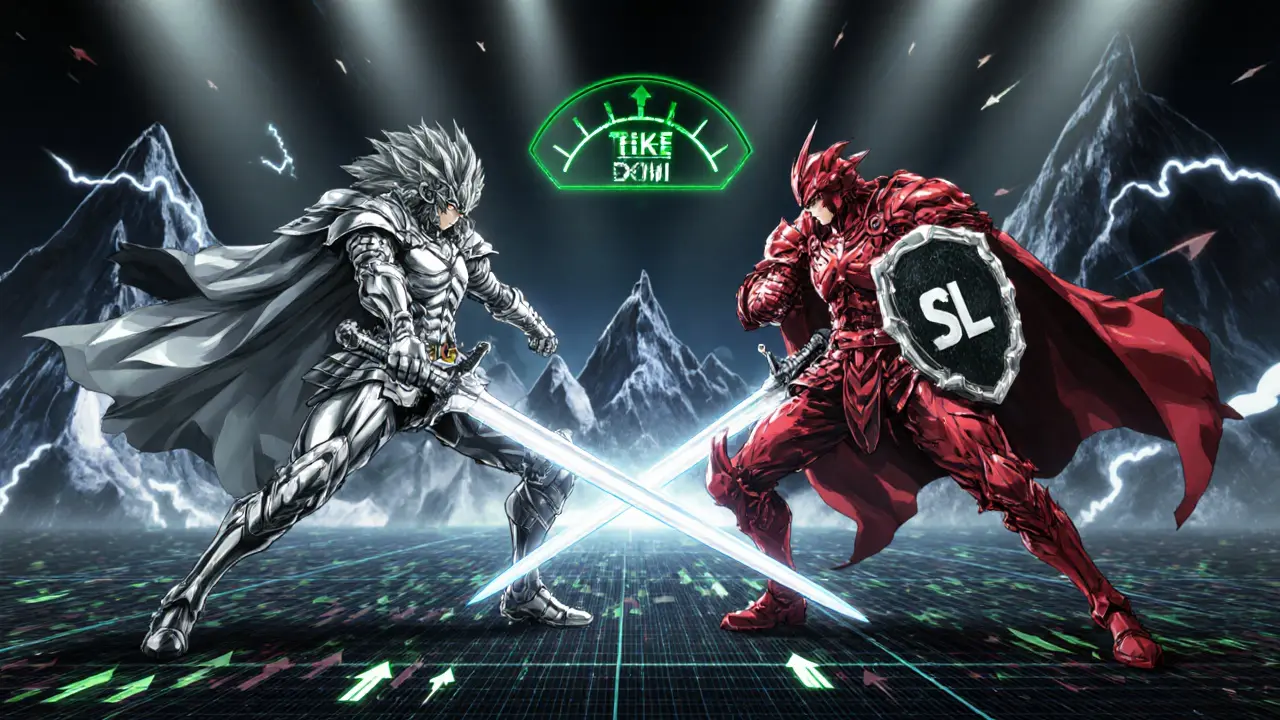Take-Profit Calculator
Risk-Reward Analysis
Risk per Unit: $0.0100
Reward per Unit: $0.0100
Risk-Reward Ratio: 1:1
Potential Profit/Loss
Total Risk: $100.00
Total Reward: $100.00
Expected Outcome: Break-even
Ever wondered how traders lock in gains without watching every tick? The secret is a simple tool that automatically closes a position once it hits a profit target. It’s called a Take-Profit Order. Below you’ll learn what it does, when to use it, and how to avoid common traps.
TL;DR
- A Take-Profit Order automatically sells (or buys back) when a preset price is reached.
- It works in forex, crypto, stocks and most brokers support it as a GTC (good‑til‑canceled) order.
- Pair it with a Stop-Loss Order to define a clear risk‑reward ratio.
- Slippage can affect execution in low‑liquidity markets; adjust the level or use limit‑style TP.
- Platforms like Oanda and Crypto.com let you set and tweak TP directly from the chart.
What Is a Take-Profit Order?
Take-Profit Order is a pre‑specified price level that automatically closes a position once the market reaches that level, securing the profit without manual intervention. Think of it as a conditional market order: when the price hits your target, the broker fires a market or limit order (depending on the platform) to exit the trade.
How It Works in Different Markets
Whether you trade the Forex Market - where a EUR/USD pair might move a few pips - or the Cryptocurrency Market - where Bitcoin can swing 5% in minutes - the mechanics stay the same. When the price crosses your TP level, the order triggers.
On most platforms, TP orders are set as Good‑Till‑Canceled (GTC). That means they stay active until they’re filled or you cancel them. For example, on Oanda, you can add a TP value in pips when you open a trade; the system watches the market 24/7 and closes the position as soon as the price hits that pip level.
Crypto.com’s derivatives interface makes TP even more visual: you drag a line on the chart, and the platform creates a limit order at that price. If the market is liquid, the order fills near‑exactly; if liquidity dries up, you might see a few ticks of slippage.
Choosing the Right TP Level
The art of setting a TP rests on technical analysis. Most traders look for support and resistance zones - price levels where the market historically pauses or reverses.
Example: you buy EUR/USD at 1.1200 with 10,000 units. Technical charts show a strong resistance around 1.1300. Setting a TP at 1.1300 gives you a $100 profit (1.1300‑1.1200) × 10,000. If the pair breaks higher, you’ll miss extra gains, but you also protect the $100 from a sudden reversal.
Scalpers might target just a few pips, while swing traders aim for larger swings of 50‑100 pips. The key is to align the TP with the trade’s timeframe and volatility. Volatile assets like crypto often require a wider TP buffer to avoid premature exits.
Take-Profit vs. Other Order Types
Understanding how TP differs from Stop‑Loss, Market and Limit orders helps you build a robust strategy.
| Order Type | Primary Goal | Typical Use | Execution Style |
|---|---|---|---|
| Take-Profit Order | Lock in profit | Exit at a favorable price | Market or limit when price hits target |
| Stop-Loss Order | Limit loss | Protect against adverse moves | Market order once stop price is breached |
| Market Order | Immediate execution | Enter or exit instantly | Executed at best available price |
| Limit Order | Price control | Enter at a specific level | Executes only at or better than set price |
Notice how TP and Stop‑Loss complement each other: one caps upside, the other caps downside. Together they form a defined risk‑reward envelope.

Pairing TP with Stop-Loss for a Clear Risk‑Reward Ratio
Most professionals aim for a minimum 1:2 risk‑reward. If you risk 20 pips with a Stop‑Loss, set a TP at least 40 pips away. This way, even if you win only 30% of trades, the wins outweigh the losses.
Platforms let you set both levels in one order ticket. On Oanda, after entering a trade you’ll see fields for “Stop Loss (pips)” and “Take Profit (pips)”. Adjust them independently, and the system will enforce both boundaries.
Psychologically, this combo removes emotional decision‑making. You can walk away from the screen knowing the trade will close on its own, either in profit or loss, according to your plan.
Platform‑Specific Tips
- Oanda: Use the “Trailing Stop” feature after your TP is partially hit. If the market moves favorably, the trailing stop will lock in additional gains.
- Crypto.com: In the spot market, enable “Auto‑TP” to let the app calculate a TP based on recent volatility. Review it before confirming.
- Always double‑check whether the platform treats TP as a market order (fills at next price) or a limit order (fills at TP or better). This impacts slippage risk.
Common Pitfalls & How to Avoid Them
Slippage: In thinly traded pairs or during high‑impact news, the price can jump past your TP, resulting in execution at a worse price. Mitigate by using limit‑style TP where the broker only fills at your exact level or better, accepting that the order might not fill.
Setting TP Too Close: Tight targets work for scalpers but can cause frequent stop‑outs in volatile markets. Align TP distance with the asset’s average true range (ATR) to give the trade breathing room.
Ignoring Market Context: A TP placed solely on a static level may miss broader trend shifts. Combine technical levels with fundamental cues (e.g., economic data releases) to confirm the target’s relevance.
Advanced Use Cases
Algorithmic traders embed TP logic into bots. The bot calculates dynamic TP levels based on real‑time volatility and adjusts them as the trade progresses. Even if you’re not coding, many charting apps now let you draw a TP line that auto‑updates when you move it, offering a semi‑automated approach.
Some traders employ “partial TP”: close half the position at the first target, then move the stop‑loss to break‑even, and let the remainder ride to a second, larger TP. This balances profit taking with upside potential.
Frequently Asked Questions
Frequently Asked Questions
Can I modify a Take-Profit Order after it’s set?
Yes. Most brokers let you edit the TP level anytime before it triggers. On mobile apps you usually tap the open trade, choose “Edit” and change the TP value. The change takes effect immediately.
What’s the difference between a market TP and a limit TP?
A market TP becomes a market order once the price hits the target, so it fills at the next available price - fast but prone to slippage. A limit TP creates a limit order at the exact target price, ensuring you never get a worse price, but the order might remain unfilled if the market gaps over the level.
Should I always use a Take-Profit with a Stop-Loss?
For most traders, pairing them creates a clear risk‑reward framework and reduces emotional decisions. Some day‑traders who aim for very short bursts may forego a TP, but they still need a stop to protect against sudden reversals.
How do I calculate a realistic TP level?
Start with recent support/resistance zones, then factor in the asset’s average true range (ATR). For example, if ATR is 30 pips on EUR/USD, a TP 2‑3× ATR above your entry aligns with typical volatility.
Can I use Take-Profit orders on stocks?
Yes. Most equity brokers support TP as a conditional order. The naming may differ (e.g., “limit sell” tied to a profit target), but the principle is the same: auto‑close when price reaches your desired profit point.
Take-Profit Orders are a cornerstone of disciplined trading. By defining where you’ll exit on the upside, you free up mental bandwidth, protect gains, and shape a risk‑reward profile that works over the long run. Pair them with solid analysis, a matching Stop-Loss, and platform features that suit your style, and you’ll trade with far less stress and far more consistency.










Comments (19)
Debby Haime
February 4, 2025 AT 06:28 AMGreat rundown! Using a take‑profit order can really lock in those sweet moves without staring at the screen all day. Pair it with a sensible stop‑loss and you’ve got a solid risk‑reward plan.
Andy Cox
February 5, 2025 AT 00:31 AMSounds solid.
emmanuel omari
February 5, 2025 AT 18:35 PMWhen you talk about take‑profit you’re really talking about a conditional execution that removes the need for manual monitoring, which is crucial for anyone dealing with high‑frequency price action. The order itself is either a market order that fills at the next tick or a limit order that guarantees price but may not fill if the market gaps over it. In FX trading, the granularity of pips means you can set a TP just a few pips away for scalping strategies, whereas swing traders might aim for dozens of pips to capture larger moves. The key is to align the TP distance with the asset’s average true range (ATR) so you’re not getting stopped out by normal volatility. For crypto, you must be even more cautious because slippage can be massive during news spikes; a limit‑style TP can save you from nasty fill‑price surprises. Remember that most brokers treat TP as a good‑til‑canceled order, meaning it will sit there even overnight, waiting for the market to hit that sweet spot. If you’re using a platform like Oanda, you can even set the TP in terms of pips directly from the trade ticket, which the system then converts to the corresponding price level. On Crypto.com, the visual drag‑and‑drop TP line simplifies the process, but you still need to watch liquidity; thin order books can cause your TP to be missed. Some traders like to use a trailing stop after the price reaches half of the TP target, which effectively moves the stop‑loss in your favor while still giving the trade room to run. This hybrid approach maximizes upside while protecting earned profit. Finally, always double‑check whether your broker executes TP as a market order (subject to slippage) or a limit order (possible non‑fill). Knowing that nuance can be the difference between a profitable trade and a missed opportunity.
Courtney Winq-Microblading
February 6, 2025 AT 12:38 PMThe philosophical angle here is that a take‑profit embodies the principle of "knowing when to let go." By setting a predefined exit, you honor the trade plan rather than succumbing to greed. It’s a quiet act of discipline that lets the market do the heavy lifting for you.
katie littlewood
February 7, 2025 AT 06:41 AMI love how this article breaks down the mechanics in a way that even newbies can grasp, yet it still offers depth for seasoned traders. The step‑by‑step calculator example is a nice hands‑on touch; you can literally plug in your numbers and see the risk‑reward ratio instantly. One thing that often trips people up is the difference between a market TP and a limit TP – the former guarantees exit but can suffer slippage, while the latter protects price at the risk of not filling at all. In my experience, I start with a limit TP on volatile assets like crypto, then switch to a market TP once the trade matures and the spread narrows. Also, don’t forget the psychological comfort: knowing your profit target is in place frees up mental bandwidth to focus on other setups. Lastly, the partial‑TP strategy mentioned near the end is a gem – close a portion, move the stop to breakeven, and let the rest ride. It’s a balanced way to capture gains while still giving the trade room to breathe.
Jenae Lawler
February 8, 2025 AT 00:45 AMWhile the guide is thorough, it glosses over the fact that many retail platforms actually charge extra for conditional orders, effectively eroding the profit margin. Moreover, the assumption that every broker supports GTC TP is optimistic; some only offer day‑only orders, which can be a hidden pitfall for swing traders.
Chad Fraser
February 8, 2025 AT 18:48 PMExactly! Set those TPs early and you can sleep peacefully knowing the trade will auto‑close at the right price.
Jayne McCann
February 9, 2025 AT 12:51 PMIf you’re too cautious you’ll miss the upside.
Richard Herman
February 10, 2025 AT 06:55 AMBalancing risk and reward is the cornerstone of any solid trading plan. By pre‑defining both stop‑loss and take‑profit, you remove emotion from the decision‑making process. It’s basically a safety net that lets you focus on finding the next setup.
Parker Dixon
February 11, 2025 AT 00:58 AM👍 Absolutely! When you lock in profit with a TP, you avoid the “what‑if” fatigue. Also, most platforms let you edit the TP on the fly, so if market conditions shift, you can adjust without reopening the trade. Keep an eye on liquidity, though – a thin market can still gobble up your TP.
Stefano Benny
February 11, 2025 AT 19:01 PMFrom a quant perspective, implementing a dynamic TP based on volatility metrics can boost expectancy. Use ATR‑scaled targets rather than static price levels to adapt to changing market regimes. That said, over‑optimization often leads to curve‑fitting, so keep the model simple and back‑test thoroughly.
Bobby Ferew
February 12, 2025 AT 13:05 PMEven if you use a dynamic TP, you still need to respect order‑book depth. Ignoring that can cause slippage that nullifies the model’s edge.
celester Johnson
February 13, 2025 AT 07:08 AMIt is ethically irresponsible to chase profit without a clearly defined exit point. A trader who neglects a take‑profit order is essentially gambling, which conflicts with the principle of responsible market participation. Moreover, the lack of a TP can lead to emotional overtrading, a behavior that harms both the individual and the broader financial ecosystem. In a disciplined approach, the TP serves as a safeguard against greed and panic. By committing to a predetermined target, you uphold the integrity of your trading strategy and contribute to market stability. Hence, any educational material that fails to stress this responsibility is doing a disservice to readers.
Prince Chaudhary
February 14, 2025 AT 01:11 AMI appreciate the moral angle, but let’s also be pragmatic – markets are messy, and flexibility can be just as important as discipline.
John Kinh
February 14, 2025 AT 19:15 PMAnother buzzword article, nothing new.
Mark Camden
February 15, 2025 AT 13:18 PMWhile brevity has its charm, reducing a complex tool like a take‑profit to a catch‑phrase undermines its strategic value. Readers deserve a thorough exposition, not a half‑hearted dismissal.
Evie View
February 16, 2025 AT 07:21 AMThis piece is a total waste of time – it’s just fluff with no real insight. If you actually want to learn, skip it.
Sidharth Praveen
February 17, 2025 AT 01:25 AMDon’t let the negativity stop you; the fundamentals here are solid and worth trying. Give the TP strategy a shot and you’ll see the benefit.
Sophie Sturdevant
February 17, 2025 AT 19:28 PMBottom line: set your take‑profit based on clear technical levels and adjust for volatility. Use a partial‑TP approach to secure gains while letting the remainder run. Always pair it with a stop‑loss to keep risk in check. With consistent practice, this becomes second nature and improves overall performance.